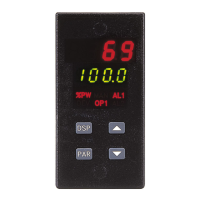Sending Commands And Data (Cont’d)
VALUE
IDENTIFIER
DESCRIPTION
SERIAL
MNEMONIC
UNITS
A Temperature Display Value TMP F/C
B Setpoint SET F/C
C Output Power PWR %
D Proportional Band PBD %
E Integral Time INT S
F Derivative Time DER S
GAlarm1 AL1F/C
HAlarm2 AL2F/C
I Deviation DEV F/C
J Output Power Offset OFP %
K Setpoint Ramp Rate RMP R
L Cooling Relative Gain CRG G
M Cooling Deadband CDB F/C
O Remote Setpoint Ratio RAT R
Q Remote Setpoint Bias BIA U
S Controller Mode 1 - Automatic
2 - Manual
(User)
U Setpoint Mode 1 - Local
2-Remote
W Output status* OST U
X Secondary Proportional Band PB2 %
Y Secondary Integral Time IT2 S
Z Secondary Derivative Time DT2 S
AA Second Input Reading IN2 U
BB Remote Setpoint Reading or
Secondary Directed Setpoint
RSP or
SP2
U
HC Heater Current Reading** HCR A
Output status transmission format = ABCD (0=output off, 1=output on)
** Interrogation of heater current value before the controller has taken a
valid heater current reading results in overload value (###.##). The heater
current reading printout is the last valid reading taken.
Note: The % output power can be changed only if the controller is in the
manual mode of operation.
* The output status indicates the status of the controller’s outputs. The status
can only be read (see the following table). The alarms outputs may be reset
by the reset operator(R).
Output Status
NON-VALVE POSITIONER
MODELS
VALVE POSITIONER MODELS
A = Main output (OP1) A = Alarm 1 output (AL1)
B = Cooling output (OP2) B = 0
C = Alarm 2 output (AL2) C = Motor close output (CLS)
D = Alarm 1 output (AL1) D = Motor open output (OPN)
Example:
OP1 = ON, OP2 = OFF, AL2 = OFF, AL1 = ON
Transmission = “ OST 1001”
Note: The % output power can be changed only if the controller is in the
manual mode of operation.
The command string is constructed by using a command, a value
identifier, anda data valueif required. TheData value need notcontain the
decimal point since it is fixed within the unit, when programmed at the
front panel. The TCU accepts the decimal point, however it does not
interpret themin any way. Leading zeros can be eliminated, butall trailing
zeros must be present.
Example: If an alarm value of 750.0 is to be sent, the data value can be
transmitted as 750.0 or 7500. If a 750 is transmitted, the alarm value
changes to 75.0 in the unit.
The address command allows a transmission string to be directed to a
specific unit on the serial communications line. When the unit address is
zero, transmission of the address command is not required. For
applications that require several units, it is recommended that each unit on
the line b e assigned a specific address.
If they are assigned the same address, a Transmit Value Command causes
all the units to respond simultaneously, resulting in a communication
collision. The command string is constructed in a specific logical
sequence. The TCU does not accept command strings that do not follow
thissequence.Only oneoperationcanbeperformedpercommandstring.

